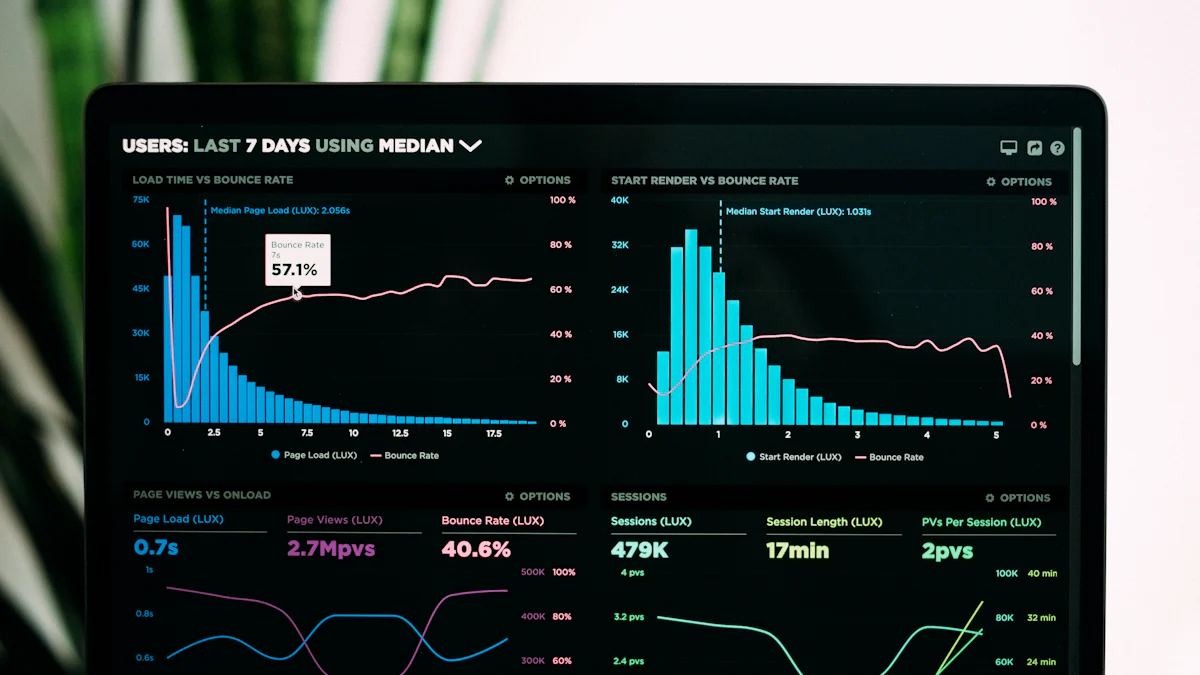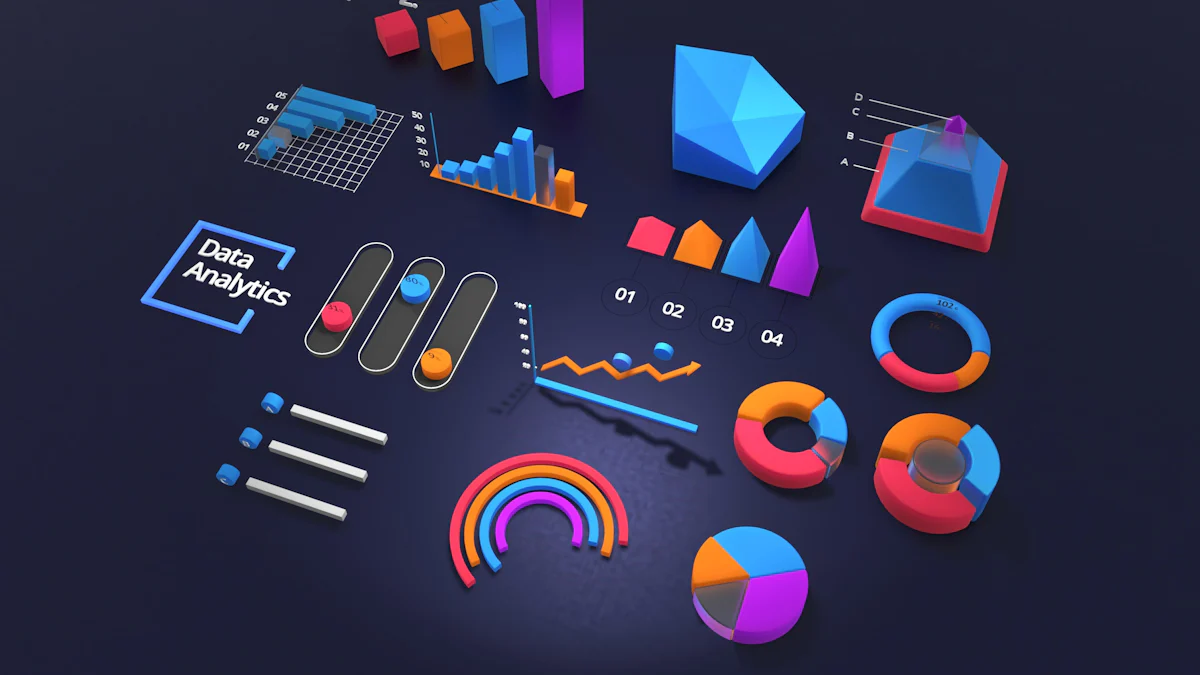How to Measure Influencer Marketing Campaign Performance in 2025

In 2025, influencer marketing has grown into a $21.1 billion industry, reflecting its immense impact on modern advertising. Measuring performance is essential to ensure your campaigns deliver value. Businesses now earn an average of $6.50 for every $1 spent, with some achieving returns as high as $20. Tracking metrics like engagement rate and conversion rate helps you understand audience behavior and optimize results. Data-driven strategies play a key role by using influencer analytics to select the right creators, refine content, and evaluate success. This approach ensures your campaigns remain effective and profitable.
Setting Objectives and KPIs for Influencer Marketing
Importance of Clear Objectives
Clear objectives form the foundation of any successful influencer marketing campaign. Without them, you risk wasting resources and running ineffective campaigns. Objectives help you define what you want to achieve and guide your strategy. Common influencer marketing goals in 2025 include:
- Boosting brand awareness.
- Driving website traffic.
- Increasing sales.
- Growing your social media following.
- Achieving measurable targets, such as a 20% increase in followers within three months.
When you set clear goals, you can measure success more effectively. For example, if your goal is to grow your audience, you can track metrics like follower growth and engagement. A data-driven approach ensures your objectives align with measurable outcomes.
Choosing the Right KPIs for Influencer Marketing Campaigns
Key Performance Indicators (KPIs) help you track progress toward your goals. Choosing the right KPIs depends on your campaign’s focus. For instance, if you aim to increase visibility, metrics like reach and impressions are essential. If conversions matter most, track actions like purchases or sign-ups.
Here’s a breakdown of effective influencer marketing metrics:
| KPI | Description |
|---|---|
| Reach | Number of unique users who see the influencer’s content. |
| Engagement | Interactions such as likes, comments, shares, and saves. |
| Conversions | Actions taken by viewers, such as clicks, sign-ups, or purchases. |
| Audience Growth | Increase in followers or subscribers on your brand’s channels. |
| Brand Sentiment | Overall tone of comments and feedback on the influencer’s content. |
These metrics allow you to measure influencer marketing performance and adjust your strategy as needed.
Aligning KPIs with Business Goals
Aligning KPIs with your business goals ensures your campaign delivers meaningful results. Start by defining objectives tied to specific outcomes, such as increasing sales or improving brand awareness. Track relevant metrics like engagement, reach, and conversions.
Set SMART (Specific, Measurable, Achievable, Relevant, Time-bound) targets to keep your campaign focused. For example, aim for a 15% increase in website traffic within two months. Use analytics tools to monitor ROI and ROAS, ensuring your efforts remain cost-effective. A data-driven approach helps you measure influencer marketing success and refine your strategy for better performance.
Key Metrics for Influencer Marketing Measurement

Engagement Metrics
Calculating Engagement Rate
Engagement rate is one of the most important influencer marketing metrics. It shows how actively audiences interact with influencer content. To calculate it, divide the total number of engagements (likes, comments, shares) by the total reach, then multiply by 100. For example, if a post receives 500 engagements and reaches 10,000 users, the engagement rate is 5%. This metric helps you measure success by understanding how well the content resonates with the audience.
Tracking Likes, Comments, and Shares
Likes, comments, and shares are essential for tracking engagement. These metrics reveal how much attention the content receives. Comments often provide deeper insights into audience sentiment, while shares indicate how willing users are to spread the message. By tracking engagement, you can evaluate the performance of social media influencers and adjust your strategy to improve effectiveness.
Reach and Visibility
Measuring Audience Reach
Reach measures the number of unique users who see an influencer’s content. It helps you understand how far your message spreads. For instance, if an influencer has 50,000 followers but only 30,000 see the post, the reach is 30,000. This metric is crucial for influencer marketing measurement because it shows how many people your campaign impacts.
Understanding Impressions
Impressions refer to the total number of times a post is viewed, even if the same user sees it multiple times. For example, if 20,000 users view a post twice, the impressions total 40,000. While reach counts unique viewers, impressions track the frequency of views. Both metrics are vital for tracking metrics like visibility and audience engagement.
Conversion and ROI Metrics
Tracking Influencer-Driven Conversions
Conversions measure actions taken by users, such as purchases, sign-ups, or downloads. You can track these using unique URLs, promo codes, or affiliate links assigned to each influencer. These tools help you identify which influencers drive the most conversions. For example, if an influencer generates 100 purchases using a promo code, you can attribute those sales directly to their efforts.
Calculating Return on Investment
To calculate campaign ROI, divide the revenue generated by the campaign cost, then multiply by 100. For example, if your influencer marketing campaign costs $5,000 and generates $20,000 in revenue, the ROI is 400%. This metric helps you measure influencer marketing ROI and determine the profitability of your efforts. By analyzing ROI, you can refine your strategy to maximize performance.
Brand Awareness and Sentiment
Monitoring Brand Mentions
Tracking brand mentions is essential for understanding how your audience perceives your brand during an influencer marketing campaign. Mentions can appear in comments, captions, hashtags, or even user-generated content. Monitoring these mentions helps you measure success by identifying how often your brand is discussed and in what context.
To track mentions effectively, use tools like influencer analytics platforms or AI-powered monitoring software. These tools can scan social media platforms for your brand name, hashtags, or related keywords. For example, if an influencer posts about your product, the tool will capture every mention, allowing you to analyze its impact. You can also manually review mentions to gain deeper insights into the tone and context of the conversations.
Real-time tracking metrics are crucial for campaign success. They allow you to adjust your strategy if needed. For instance, if mentions spike after a specific post, you can replicate that content style to maintain momentum. By combining manual reviews with automated tools, you can ensure no mention goes unnoticed, giving you a comprehensive view of your campaign’s performance.
Analyzing Audience Sentiment
Understanding audience sentiment is key to evaluating the effectiveness of your influencer marketing campaign. Sentiment analysis reveals whether your audience views your brand positively, negatively, or neutrally. This insight helps you refine your strategy and improve future campaigns.
You can analyze sentiment using several methods:
- Keyword analysis identifies positive or negative words in comments and mentions.
- Sentiment analysis tools use AI to evaluate language cues automatically.
- Manual review allows you to interpret comments for a more nuanced understanding.
- Contextual understanding ensures you consider the full meaning behind each mention.
- Trend analysis tracks sentiment over time, helping you identify patterns.
- Engagement metrics, such as likes and shares, provide additional clues about audience sentiment.
For example, if your campaign generates mostly positive comments and high engagement, it indicates strong audience approval. On the other hand, negative feedback may signal areas for improvement. By regularly analyzing sentiment, you can measure success and ensure your influencer marketing metrics align with your goals.
Actionable Methods for Measuring Campaign Success
Using Affiliate Links and Promo Codes
Affiliate links and promo codes are powerful tools for measuring influencer marketing success. They allow you to track the direct impact of influencers on your campaign. Assign unique links or codes to each influencer. This approach helps you identify which collaborations drive conversions and increase sales.
Using these tools offers several benefits:
- More traffic to your website.
- Lead generation through targeted promotions.
- Boosted visibility and brand awareness.
- Easier tracking of influencer campaigns.
For example, if an influencer shares a promo code, you can measure how many users redeem it. This data provides clear insights into the performance of your influencer marketing campaign. By analyzing these results, you can refine your strategy to foster engagement and improve ROI.
Leveraging UTM Parameters for Influencer Analytics
UTM parameters enhance your ability to measure influencer marketing success. These short text additions to links provide detailed information about traffic sources. They remain unaffected by cookie changes and integrate seamlessly with analytics tools.
Tagging influencer links with UTM codes allows you to track the source, medium, and campaign name. For instance, you can see whether traffic came from Instagram or YouTube. Using unique UTM parameters for each influencer reveals which partnerships yield the highest ROI. This data helps you evaluate campaign effectiveness and optimize future strategies.
Tracking Website Traffic and Conversions
Tracking website traffic and conversions is essential for measuring influencer marketing success. Use tracking codes and unique links for each influencer to attribute visits and sales accurately. Custom landing pages tailored to influencers can further enhance tracking and engage potential customers.
Follow these best practices:
- Source: Identify the channel where traffic originated, such as Instagram or TikTok.
- Medium: Categorize traffic channels like social media or email.
- Campaign: Specify the purpose of the link to differentiate promotions.
Additionally, tracking pixels collect data on user behavior after visiting your site. This information helps you understand how influencers drive conversions and improve campaign performance. As one expert advises, “Remain focused on the number one metric that lines up with your priority objective for the campaign.” By focusing on key metrics, you can ensure campaign success and refine your strategy for better results.
Conducting Post-Campaign Surveys
Post-campaign surveys are a powerful way to measure influencer marketing success. They provide direct feedback from your audience, helping you understand the effectiveness of your campaign. Surveys allow you to gather insights that metrics alone cannot reveal, such as audience perception, preferences, and emotional responses.
To create an effective survey, focus on asking clear and concise questions. Use a mix of multiple-choice, rating scale, and open-ended questions to collect both quantitative and qualitative data. For example, you can ask, “How likely are you to purchase the product after seeing the influencer’s content?” or “What did you like most about the campaign?” These questions help you measure the impact of your strategy on audience behavior and sentiment.
Distribute your survey strategically to maximize responses. Share it through email, social media, or even as a pop-up on your website. Incentivize participation with discounts, giveaways, or exclusive content. For instance, offering a 10% discount code can encourage more users to complete the survey.
Analyze the results to identify trends and areas for improvement. Look for patterns in responses that highlight what worked well and what needs adjustment. If many respondents mention that the content felt authentic, you know your influencer selection was on point. On the other hand, if feedback suggests the messaging was unclear, you can refine your strategy for future campaigns.
By conducting post-campaign surveys, you gain valuable insights into your audience’s thoughts and feelings. This approach complements other metrics, helping you measure influencer marketing performance more comprehensively. It also ensures your ROI improves with each campaign iteration.
Tools for Influencer Marketing Measurement

Social Media Analytics Platforms
Social media analytics platforms help you track the performance of your influencer marketing campaigns. These tools provide insights into engagement, reach, and audience behavior. Here are some of the top platforms you can use:
- Upfluence: Uses machine learning to find creators and measure campaign performance.
- HypeAuditor: Offers AI-powered influencer discovery and audience analysis.
- Emplifi: Grades content with AI to boost engagement and reach.
- Grin: Provides a free tool for tracking influencer performance metrics.
- Creator.co: Focuses on micro-influencers and offers detailed demographic data.
- Socialinsider: Tracks campaign performance and engagement.
- Later: Simplifies influencer program management.
- Social Blade: Delivers influencer statistics across major platforms.
- Keyhole: Tracks hashtag campaigns effectively.
- Buzzsumo: Helps discover content and influencers.
These platforms allow you to monitor campaign effectiveness and make data-driven decisions to improve results.
Influencer Marketing Platforms
Influencer marketing platforms simplify campaign planning and execution. When choosing a platform, look for features that enhance productivity and provide actionable insights. A user-friendly interface ensures you can manage campaigns efficiently. An extensive influencer database gives you access to a wide range of creators. Advanced search filters help you find influencers who align with your goals. Strong analytics tools let you assess campaign performance in real time. Responsive customer support ensures you can resolve issues quickly.
By selecting the right platform, you can streamline your influencer marketing efforts and maximize campaign effectiveness.
Google Analytics for Campaign Tracking
Google Analytics is a powerful tool for tracking your influencer marketing campaigns. Follow these steps to make the most of it:
- Set up campaign parameters for influencer links to identify traffic sources and mediums.
- Create custom segments to isolate traffic and conversions from influencer campaigns.
- Use attribution models to understand how influencers impact the customer journey.
- Generate custom reports to visualize and share campaign results.
- Leverage the Model Comparison Tool to optimize influencer attribution.
These features help you measure campaign performance and refine your strategy for better results.
AI-Powered Influencer Analytics Tools
AI-powered influencer analytics tools have revolutionized how you measure the success of an influencer marketing campaign. These tools use advanced algorithms to provide deeper insights into influencer performance and campaign effectiveness. They help you make smarter decisions by automating complex processes and delivering actionable data.
Modern tools offer several cutting-edge features:
- Influencer Discovery: AI evaluates influencers based on audience demographics, engagement rates, and niche relevance. This ensures you collaborate with creators who align with your goals.
- Campaign Management: These tools simplify your workflow with dashboards for tracking budgets, timelines, and deliverables.
- Performance Tracking: AI analyzes metrics like ROI, reach, and audience engagement, giving you a clear picture of your campaign’s impact.
- Fraud Detection: Algorithms identify fake followers or bots, ensuring you work with genuine influencers who deliver real results.
Platforms like Traackr, GRIN, and Buzzsumo lead the way in influencer marketing analytics tools. Traackr helps you track spending and ROI, aligning your investments with measurable outcomes. GRIN offers a Creator Discovery Suite and real-time ROI tracking, making it easier to evaluate campaign performance. Buzzsumo focuses on content and influencer discovery, helping you connect with impactful creators and analyze their effectiveness.
By using these tools, you can optimize your influencer marketing strategy. They save time, reduce guesswork, and ensure your campaigns deliver maximum value. Whether you want to track conversions or monitor audience sentiment, AI-powered tools provide the insights you need to succeed.
Tip: Always choose tools that match your campaign goals and provide detailed analytics. This ensures you get the most out of your influencer marketing efforts.
Optimizing Influencer Marketing Campaigns
Analyzing Campaign Data for Trends
Analyzing campaign data helps you identify trends and improve future influencer marketing efforts. Start by setting clear objectives. Define what you want to achieve, such as increasing engagement or driving conversions. Next, identify key performance indicators (KPIs) that align with your goals. For example, track metrics like reach, impressions, or ROI.
Use analytics tools to collect relevant data. Compare this data against your objectives and KPIs to uncover patterns. For instance, you might notice that posts with specific hashtags generate higher engagement. Evaluate influencer performance by assessing how well they met your campaign goals. Finally, calculate ROI to measure the campaign’s profitability. Use these insights to make adjustments and refine your strategy for better results.
Refining Influencer Selection
Choosing the right influencers is crucial for campaign success. Focus on engagement rates rather than follower counts. Influencers with high engagement often drive better conversion rates. Use platforms like BuzzSumo to find creators whose audience aligns with your brand’s niche.
Consider the influencer’s overall aesthetic and content quality. Ensure their values match your brand to maintain authenticity. Analyze their audience behavior to confirm they can influence effectively. Review their past partnerships to gauge their reliability. By refining your selection process, you can collaborate with influencers who enhance your campaign’s performance.
| Criteria | Description |
|---|---|
| Engagement Rates | Prioritize engagement rates over follower counts as they drive better conversion rates. |
| Audience Alignment | Use platforms like BuzzSumo to find influencers that resonate with your brand’s niche. |
| Brand Values | Build relationships with influencers who share your brand values to enhance authenticity. |
Improving Content Strategies
Strong content strategies boost the effectiveness of your campaigns. Treat influencers as collaborators. Work together to create authentic content that resonates with their audience. Establish long-term relationships with niche influencers to build trust and consistency.
Focus on your campaign objectives to guide content creation. For example, if your goal is to increase engagement, encourage influencers to create interactive posts like polls or Q&A sessions. Continuously measure performance to identify what works best. Use this data to refine your approach and improve future campaigns.
Tip: Express gratitude to influencers for their efforts. A positive relationship fosters better collaboration and results.
Iterating for Continuous Improvement
Continuous improvement is essential for maximizing the success of your influencer marketing campaigns. By iterating on your strategies, you can uncover what works best and refine your approach to achieve better results. This process involves analyzing past campaigns, testing new ideas, and making data-driven adjustments to enhance performance.
Start by reviewing your campaign data. Look for patterns in metrics like engagement, reach, and conversions. Identify areas where your campaign excelled and where it fell short. For example, if certain influencers generated higher engagement rates, consider collaborating with them again. If specific content formats performed poorly, explore alternative styles or messaging.
Testing different approaches is key to discovering the most effective strategies. Experiment with various influencers, platforms, and content types. For instance, you might compare the impact of short-form videos on TikTok versus carousel posts on Instagram. Each iteration provides valuable insights that help you refine your tactics. Over time, this process leads to improved ROI and greater brand awareness.
Feedback also plays a critical role in continuous improvement. Gather input from your audience, influencers, and team members. Post-campaign surveys can reveal how your audience perceived the campaign, while influencers can share insights about their followers' preferences. Use this feedback to fine-tune your strategy and create more impactful campaigns.
Remember, the goal of iteration is not just to fix what went wrong but to build on what went right. By continuously testing, analyzing, and refining, you ensure your campaigns remain relevant and effective in a rapidly evolving digital landscape. This approach not only boosts your campaign’s performance but also strengthens your overall influencer marketing strategy.
Tip: Treat each campaign as a learning opportunity. The insights you gain today will shape the success of your future efforts.
Setting clear objectives and tracking key metrics are vital for ensuring the success of your influencer marketing campaigns. By understanding your audience and platform, you can tailor goals and select relevant KPIs like engagement or conversions. Tools such as audience analyzers and ROI calculators simplify performance tracking, offering actionable insights to refine strategies. Staying competitive in 2025 requires leveraging data, fostering authenticity, and experimenting with trends. A data-driven approach ensures your campaigns remain impactful and adaptable in a saturated market, maximizing their effectiveness and long-term value.
FAQ
What is the most important metric for influencer marketing success?
The most important metric depends on your campaign goal. For engagement-focused campaigns, track likes, comments, and shares. For sales-driven campaigns, monitor conversions and ROI. Always align metrics with your objectives to measure success effectively.
How do you calculate ROI for influencer marketing campaigns?
To calculate ROI, divide the revenue generated by the campaign cost, then multiply by 100. For example, if your campaign costs $2,000 and generates $8,000 in revenue, the ROI is 400%. This formula helps you evaluate profitability.
How can you ensure influencers align with your brand?
Evaluate their audience demographics, engagement rates, and content style. Check their past collaborations to ensure consistency with your brand values. Use influencer marketing platforms to analyze their authenticity and relevance to your niche.
What tools are best for tracking influencer performance?
Use tools like Google Analytics, Traackr, and HypeAuditor. These platforms provide insights into reach, engagement, and conversions. AI-powered tools also detect fake followers and analyze audience sentiment, ensuring accurate performance tracking.
How do you measure brand awareness in influencer campaigns?
Track metrics like brand mentions, hashtag usage, and audience reach. Use sentiment analysis tools to understand how audiences perceive your brand. Combine these insights with engagement data to evaluate the campaign’s impact on awareness.
See Also
Key Influencer Marketing Trends To Monitor This Year
Decoding The ROI Of Influencer Marketing Strategies
Essential Influencer Marketing Platforms For 2024 Success
Practical Influencer Marketing Data For Better Tactics
Crucial Influencer Marketing Statistics Every Marketer Should Know
